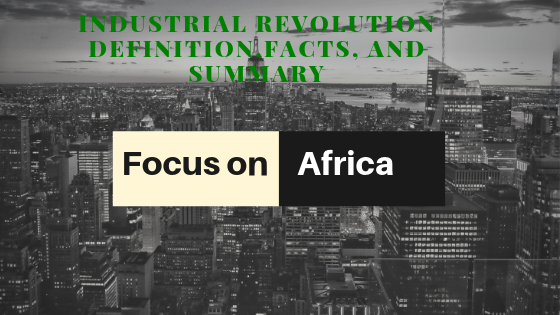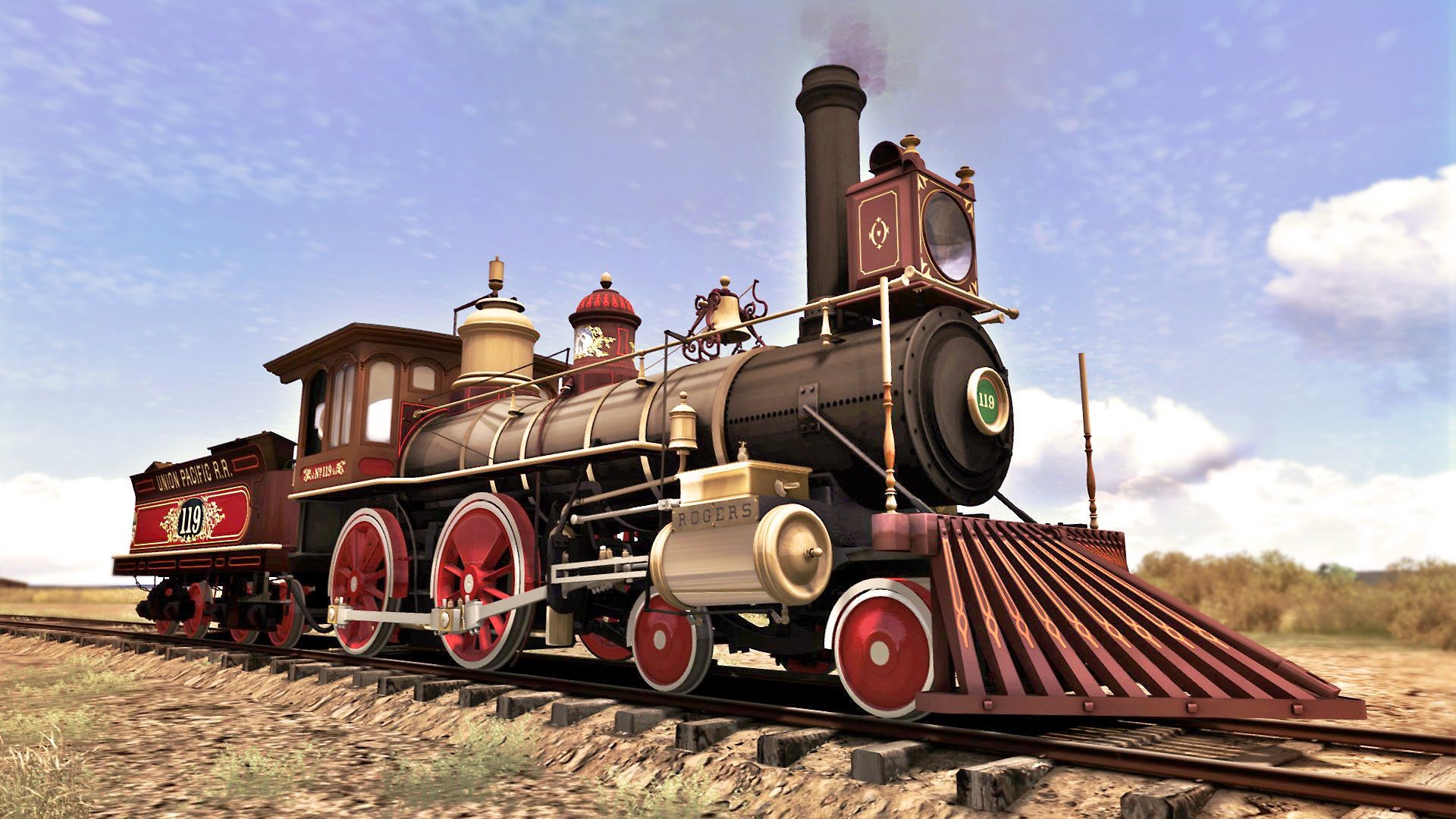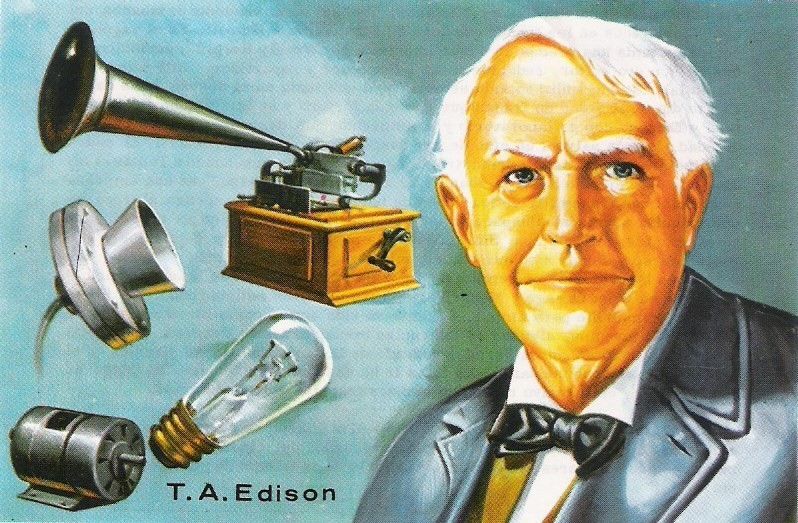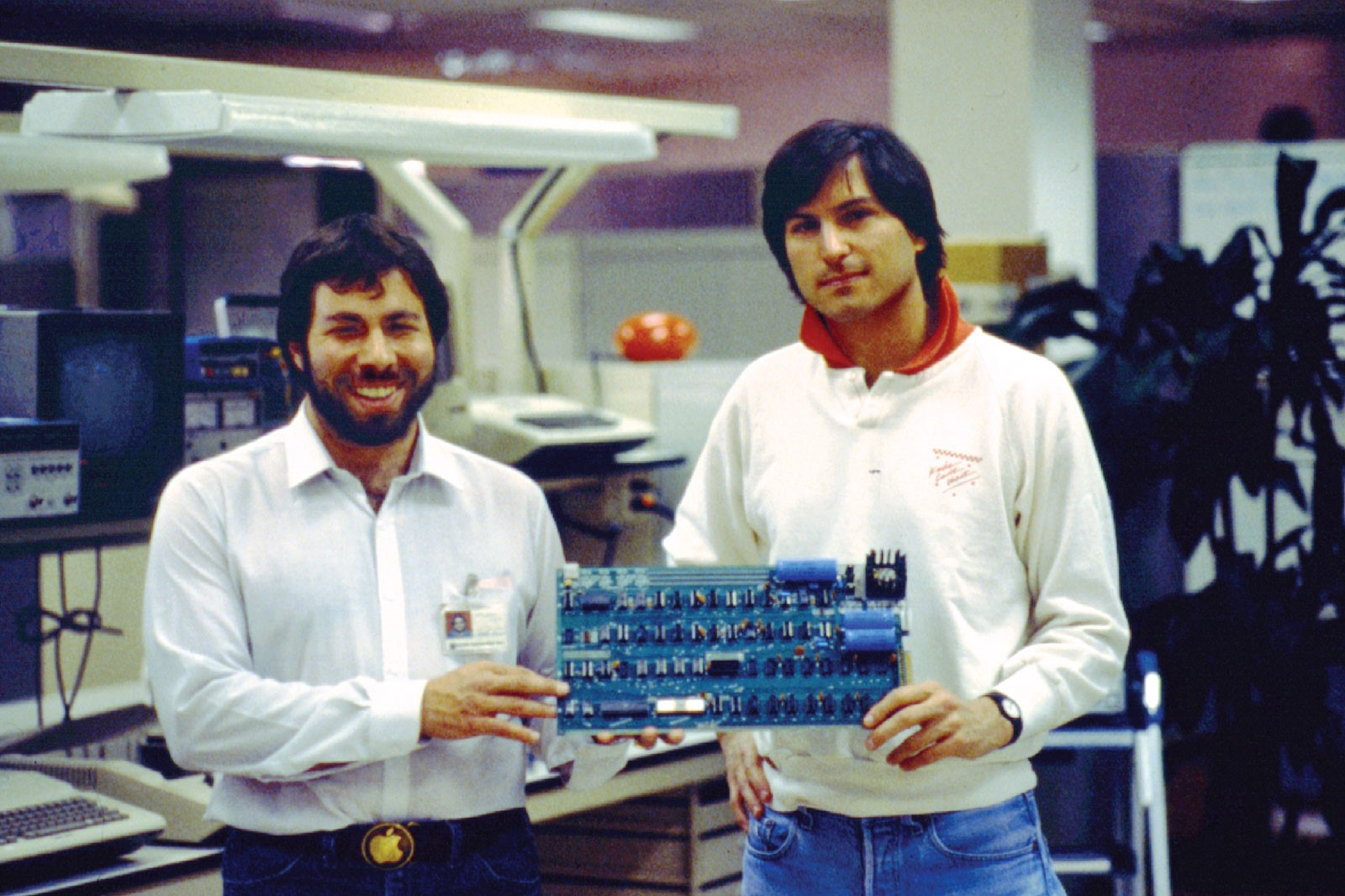Industrial Revolution Definition,Facts and Summary: Focus on Africa
Published on July 27,2019

Industrial Revolution is a period of rapid social and technological change that has transformative power. It shapes the world we live in. These periods are marked by great innovations which often are the defining characteristics that separate one from the other. Throughout recorded history, humanity has witnessed three such periods. These are famously coined industry 1.0, 2.0,3.0 and 4.0. Industry 4.0 is, however, a period that is currently unfolding and it still remains obscure to many. In order to understand it, one needs to appreciate its predecessors, their etymology, defining characteristics and the technologies that were created during the periods. This together with the African situation on the Industrial revolution, is what I wish to discuss in this article. Part 2 of this article will in-depth describe industry 4.0.
Industry 1.0
Wake up, Africa!! We are rapidly approaching the third century since the dawn of Industry 1.0 in 1760. It was the original industrial revolution, characterized by division of labor and driven by steam/hydropower. It changed everything from agriculture, textile and metal manufacture, transportation, economic policies, and the social structure. It began in the modern-day United Kingdom (England, Scotland, Wales, Ireland) and spread to Europe, the Americas, and the Asia Pacific.
Africa during Industry 1.0
Circumstantially, industry 1.0 also led to the demand for the African production power who occasionally spread herself lazily, bare-chested, on the warm savannah after repeatedly drinking herself up with the bitter palm wine. Cheap and readily available through walk-through conquests and corrupt clan chiefs, the African think tank, since the mid-1700s till the 1860s, were easily hurled into slave ships, and later on used as the factors of production for the strong in their domiciles. The wanton African chiefs received pennies and occasional scars of war (for the daring only) as their rewards, yet their communities were left brain drained. Africa missed industry 1.0; we literally missed it. We never saw our own Watt engine neither did we see Eli Whitney’s Cotton Gin or something of equal measure.
Notable technologies of Industry 1.0

- John Kay’s Flying Shuttle (1733) that made weaving easy. It led to the significant expansion of the textile industry
- James Hargreaves’ Spinning Jenny (1764). It allowed workers to spin more wool at a time. Together with the Flying Shuttle, they changed the textile industry forever.
- James Watt’s Steam Engine (1775). It replaced the less efficient Newcomen’s engine. Hands down, it was one of the greatest inventions of Industry 1.0. It would lead to the development of locomotives and massive leaps forward in ship propulsion.
- Eli Whitney’s Cotton Gin (1794). Another landmark of Industry 1.0 that would reshape agriculture and textile industries.
- The Telegraph (the early 1800s). A notable first man’s attempt at near-instant communication which soon became the de facto means of communication for business and private citizens long distance.
- This period also produced the matchstick, hydrogen fuel cell, Portland cement, modern roads, Bessemer process for steel manufacture, Volta’s first Modern battery, the train locomotive, etc.
Industry 2.0
Then came Industry 2.0 in the 1870s where electric power was a major innovation, and a prime driver of growth & development. It brought about new steel making processes, mass-production, assembly lines, electrical grid systems, the large-scale manufacture of machine tools and the use of increasingly advanced machinery in steam-powered factories. A notable mark of this period was the first use of assembly lines in the production of automobiles by Henry Ford that led to the famous Model T. Never forget that without Thomas Alva Edison a.k.a the Wizard of Menlo Park, about 1093 inventions would be missing in this world including the light bulb. Anyway, one would argue that Nicola Tesla would have eventually made one, but he didn’t. Edison and Tesla were like the Gates and Jobs of our time; the hardware and the firmware that coupled to make the machine. Without either party, nothing would simply be that useful. Find out why here under the subsection of “code: the spirit of the machine”.
Africa in Industry 2.0
By this time only 10% of Africa was under ‘formal’ European control since the beginning of the slave trade. But the strong saw it fit to abolish the slave trade, for only after a century, did slavery appear to them as ‘inhuman’. The strong soon realized that they couldn’t do without their selfless servants and so convened in Berlin, Germany in 1881 to create the famous Rape of Africa. In books, they called it Scramble for and Partition of Africa. Here, the strong decided to come to her relentless servant. “If thou dost see it rude for me to summon you from your dwelling, then I shall personally come to you and craft your environ till you live as I see it fit.”
Keep in mind, if a visitor arrives at your home, you are forced to cover your nakedness even if thy nakedness was the source of thy pleasure. You are forced to accommodate him. Simply put, you can’t think for yourself, neither can you live by yourself. Africa never thought for herself and never lived by herself for the strong was there to supervise what Africa thought and lived by. The strong took for themselves our resources and used them to further their own courses. They also saw it fit to use my grandfathers as war machines fit for launching and ducking bullets and missiles in 1914-18 and 39-45 European tribal wars (remember, the Roman empire, as was foreseen by the great Nebuchadnezzar in his vision of the centuries, fell apart into the ten European Kingdoms. America is English) famously, world wars. Again we missed Industry 2.0; Africa did not have her own Menlo Park let alone the wizard that ran it. We never had (Thomas Alva) Edison Light Bulbs of our own. It’s no wonder why I used paraffin lamps to study when I was a kid.
Technologies of industry 2.0

- Sir Henry Bessemer’s Process for steel manufacture. Invented in the 1860s but only made available in 1870. It made steel manufacture very feasible and everything, from household items to locomotives, went steel. Including Model T.
- Karl Friedrich Benz's first practical automobile (1885). The German was simply a genius in action. He is the father of Mercedes Benz, think no further.
- Henry Ford’s Model T automobile (1908). Regarded as the first affordable automobile, it opened travel to the common middle-class American. Inspired by the Chicago meatpacking industry’s assembly lines, the car was easily mass-produced and the ripple effect would be felt worldwide. Model T easily won ‘the most influential car of the 20th century’ award in 1999.
- The Genius of Thomas Alva Edison (American). Edison brought the phonograph, carbon telephone transmitter, electric light through the light bulb, DC power electric distribution grids, motion pictures, etc. Think of the little genius Charlie Chaplin, think of Edison’s Kinetoscope without which Kodak or Hollywood would not be.
- The Genius of Nikola Tesla (Serbian later naturalized US citizen). Probably the best practical futurist of all time (Dr. Michio Kaku would fit his shoes if only he went practical on his thoughts), Tesla brought the AC power and grid that powers every electrical appliance in your home, the tesla coil (death coil), X-ray experimentation, radio remote control, Wireless Power, bladeless turbine, etc.
- Orville and Wilbur Wright’s Flyer (1903). The two made the first controlled, sustained flight of a powered, heavier-than-air aircraft. They would later on, in 1903-04 develop their flying machine into the first practical fixed-wing aircraft, the Wright Flyer III. Think of Boeing or Airbus, think of the Wright brothers.
Industry 3.0
Presently, we are at the edge of Industry 3.0 which has been primarily driven by Information & Communications Technologies (ICT) enabling both manufacturing and service sectors to achieve many gains. With it came the emergence of a new type of energy whose potential surpassed its predecessors; nuclear energy. This revolution which began in 1969 witnessed the rise of electronics, with the transistor and microprocessor, but also the rise of telecommunications and computers. These new technologies are so powerful that they have literally created another world within our world vis-a-vis the production of miniaturized material which would open doors, most notably to space research and biotechnology. This revolution also gave rise to the era of high-level automation in production, following the invention of two automatons, programmable logic controllers (PLCs) and robots. Inventions of this period are so radical and exponential in nature that they occasionally get renovated.
Where was the mother Africa when all this began?
We were right in our homes. Albeit shaken by wars of independence, we were home! The big Brother gave us our own flags in the pretext of independence, as they left for their homes (we managed to violently dispel some). We were left to choose our own leaders and rule ourselves through a foreign system of governance that was literally alien to our traditions and peaceful ways of life. Not knowing what to do, we quickly poured our hopes and dreams to the open hands of a select few who had had a taste of the big brother’s government and therefore knew how to run it, or so we assumed. The big brother installed the puppets.
The simpleton African, masquerading as an elite, soon saw opportunities to grab wealth for himself. How dare he!! I gave him my life to look after but all he saw were a myriad of ways of making me naked. Since the simpleton only cared about himself, soon corruption, majorly in form of tribalism, flocked in. The big brother also saw it fit to only support the simpleton that supported him. If any upright African tried standing up against his mean ways, then he would simply bite the dust; and so R.I.P Thomas Isidoe Noel Sankara of the Burkinabe people, Patrice Emery Lumumba of the rich Congo, Thomas (Tom) Joseph Mboya of my country land Kenya, Dr Osagyefo Kwame Nkurumah of the United Gold Coast. One by one our think tanks were betrayed by our own greedy leaders who, notably Mobutu Sese Seko Zaire, were after everything else including naming their countries after themselves.
Africa has all the resources she needed to create her own Industry 3.0. But all these were channeled through mean hands of her own leaders. It’s unfortunate that even now the transfer and not the exchange of wealth is happening. You African, don’t think corruption is new, never believe that it was a craft of yesternight. The menace was the founding father of your country. It was here before the flag.
Technologies of Industry 3.0

- Logical thinking by George Boole a.k.a Boolean Algebra (borrowed from Industry 2.0 in 1854) and the first mechanical computer from Charles Babbage, Boole’s collaborator (1820s -70s)
- John Ambrose Fleming’s Vacuum tube of 1904, Edgar’s 1926 Field-Effect transistor to Shockley Lab’s point-contact Transistor in ‘47, and Integrated Circuits (IC) of the 1960s that led to Intel’s 4004 and 8008 microprocessors and later on the ubiquitous Intel’s 8051 microcontrollers.
- The Personal Computer right from the ENIAC of ‘46 to the two brilliant Steves (Wozniak and Jobs) who created Apple 1 in 1976. Apple 1 changed our view of the PC.
- The PC ain’t functional unless fitted with a software. 1976 featured the founding of the world’s first-ever software company, Microsoft (it isn’t powerful lest it is micro) by Bill Gates and Paul Allen. They went on and created Windows and other ingenious software. This also woke up the man from Helsinki, Finland, Linus Benedict Torvalds to create the best OS ever (by my standards) Linux.
- The Internet from ‘69s ARPANET project for the US DOD, and the World Wide Web of ‘89 by the English Geek Sir Tim Bernes Lee. The Internet is the connectivity part, World Wide Web (WWW) on the other hand is the organization of information exchange across networks. Think HTML, HTTP, Browser and Web Engines like Google’s V8 then think of Tim. He recently made us aware, through a TED talk, that he is currently building the Internet of data.
Conclusion: Industry 4.0
Yet I had mentioned earlier that we are currently at the edge of Industry 3.0. As if a pendulum of the grandfather’s clock, we are swinging from Industry 3.0 to Industry 4.0 and back. The momentum of the swing will for sure be consumed. Read my Life’s analogies to find out why. The modern-day sensors, RFID chips, ‘cyber-physical systems and the Internet of Things (IoT) are transforming manufacturing and services across their entire supply chains. These are the base movers of other transformative technologies of Industry 4.0. They will be discussed in-depth in part 2 of this article. My African brother, are you ready for Industry 4.0, or will article 2 simply whack you left and right on the cheek with jargon? Seek yee and find thy soul for time waits for no one.